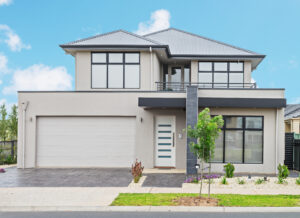What’s The Average Cost To Build A Home In Australia In 2022?

There were two major unexpected outcomes of the COVID-19 pandemic in the real estate industry in Australia: the intense rise in property values and the increasing cost of new home builds. Thanks to various factors (including disruptions to global supply chains), the cost of seeing an empty lot transform into a new home is significantly different in 2022 than in 2019.
There are key factors to consider when pricing up a new build. These include the location of the home, the size of the block of land, the cost of that land, particular finishes, the competitiveness within the market at the time of the build, any additional features and more. By breaking down each of these factors, homeowners can get a sense of what’s in store for them should they decide to pursue a new build.
The impact of global supply chain issues
How did many Australians in constant lockdowns keep themselves busy across 2020 and 2021?
The answer; planning and undertaking renovations!
With more Aussies spending time at home, many homeowners started to pay close attention to those spaces. This spurred on renovation activity. The flow-on effect led to worker shortages, with a lack of skilled labourers in comparison to the demand of the market, creating long lead times and the ability for increases in service prices.
The Australian government also looked to stimulate the economy by announcing a raft of support measures. Many of these were aimed at first home buyers. Not only were home-building hopefuls then left bidding against each other for attractive blocks of land, but they were also scrambling to lock in new build windows within an overtly hot market.
Increased material costs, decreased margins
Fast forward to 2022, and that market pressure has been compounded by rising materials costs. Generally, contracts are executed months ahead of the build itself commencing. This means the value of contracts executed before supply chain issues emerged, puts pressure on the builder’s bottom line. Thanks to the increased cost of supplies, builders absorb these prices into their margins, unable to pass them on to their clients. There’s also the simple issue of availability, with many items, including specific types of timber, no longer available.
This isn’t just frustration over margin bottom lines. This downward pressure creates an increased danger of survival for many building companies. Decreased margins lead to unstable cash flow, meaning the timing of single invoices landing can become make-or-break for many builders.
Shipping delays
Have you paid through the nose for building materials? Time to enjoy a delay in freight shipping on top. The global supply chain issues have wreaked havoc on the shipping of key materials, leading to further budget blowouts for builders who need to push out build timeframes. Whether or not materials are on-hand as planned, employees must be paid. Many builders struggle to align labour availability with the timing of incoming materials caught up in shipping delays.
Land availability and pricing
Purchasing a block for your dream home isn’t as simple as just looking for a piece of land in the suburb of your choosing. With more and more blocks squeezing into new estates, finding a block that’s the right size and shape for your intended design can be challenging. The block’s frontage, its size, and the type of land you’re securing all have an impact on the bottom line.
There’s a reason some smaller blocks may be dramatically higher in price than larger blocks in the same neighbourhood. Sloping blocks need much more investment when it comes to building a new home. This is one key area of consideration for buyers looking to control their costs.
The average cost of land varies between states across Australia. Empty blocks within inner-city suburbs go for a premium, while suburbs within the city fringes see a rush from investors and first home owners alike. Finding a block that fits with your vision for your new home is the first step in analysing how much remains for that dream home build.
The ABS outlook: the average cost of building a new home
We can thank the ABS data for giving us an average cost of building at $1393.55 per sqm. It’s important to note that this figure doesn’t stretch to include design, any required planning permits, site work necessary for your specific block, and upgrades common to new home builds.
There is, of course, a wide range in the market when it comes to this per sqm average. A volume builder sits at the low end of the scale, while an architecturally-designed home may come in at more than double this average. As architecturally-designed homes are unique in nature, their design, planning and approvals can dramatically impact the bottom line.
One way in which first homeowners, in particular, can look to save costs is in working with flexible floor plans from major builders. Many building companies have existing floor plans which provide accurate price estimates, with in-house designers able to work with clients to customise floor plans. This is one way for those entering the market to decrease their build cost while still having the flexibility to customise an existing floor plan for their needs.
Areas where you can save
If you’re looking to decrease your spending while building a new home, there are some simple areas where you can conserve your budget.
Landscaping is one area where many homeowners opt to DIY (or to hire a professional a few months down the line, when they’ve had more of a chance to save). By removing landscaping factors from house and land packages, homeowners can reduce the bottom line of their build costs.
Upgrades are also one area where people often look to push their budget parameters. While some elements can be easily replaced later, considering which upgrades are most cost-effective to include in the initial build is a smart way to conserve cash without sacrificing the home’s long-term comfort.